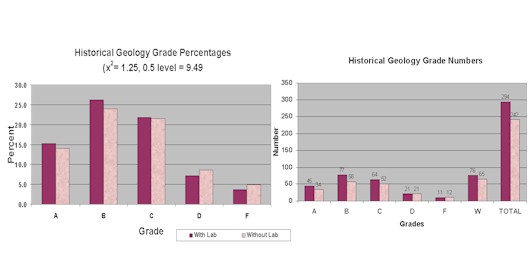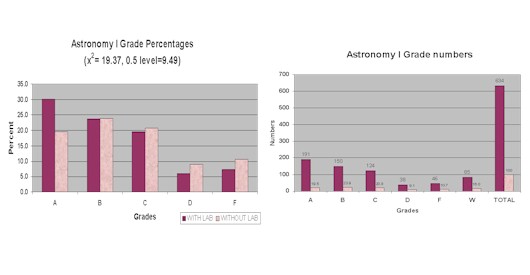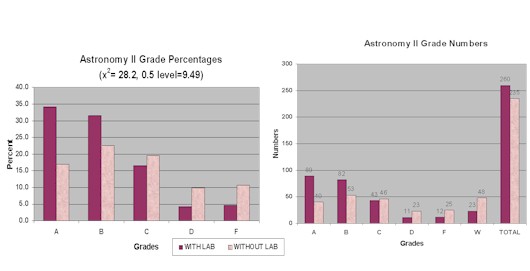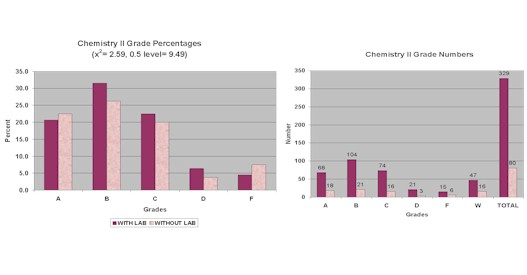|
In addition, most instructors can
point to many case studies that provide evidence for this contention.†
However, studies with data comparing the performance of students
taking lab with those taking only the lecture are hard to find.
At Georgia Perimeter
College, a 2-year transfer institution, a change in the State
Regentís Policy provided an opportunity to obtain data to help
measure the value of labs.† The old core curriculum required an
eight-hour lab-science sequence for a non-science major.† Beginning
in 1998 this was changed so that only seven hours of science were
required which did not need to be sequential.† In addition only
one lab was required.
The various science
disciplines responded to the new policy in a number of ways. Both
the astronomy and geology sequences were converted into two non-sequential
courses with lab optional. Survey chemistry maintained the sequence,
but made lab optional.
Biology
was so convinced that labs should be maintained that rather than
make labs optional, some courses were shortened to 3 hours including
lab.
In
an effort to support the biologists' decision to keep the labs,
I realized that we could look at data from our other science offerings
in which the lab was optional. In those classes, we have students
side-by-side in lecture, some of whom are taking lab and others
who are not. Data on their lecture performance were compiled in
order to compare the two groups.
The data compiled
were from 188 classes of geology (55), astronomy (48) and survey
chemistry (85).† These were taught from Fall 1998 to Summer 2000
on five campuses, including both day and evening classes.† In
addition they included classes taught by full and part time instructors
and face-to-face as well as a few online classes.† The grades
of 4,603 students (3363 enrolled in lab and 1240 in lecture only)
were included.
The grade distributions
for lecture of the students taking the lab and those who had elected
not to take the lab were compared for each of the six courses.
The distribution of grade percentages between those with and without
lab was significantly different in four of the six courses (Figure
1.) and the same trend, though not significant was seen in the
other two. In all cases the average grade was higher for those
taking the lab, and in all courses except Chemistry II, a higher
percentage of students taking lab made Aís and Bís.
Figure 1.† Comparisons of grades between
students enrolled in lab and those not enrolled in labs of various
courses.






The number of withdrawals
by students who were enrolled in the lab was also compared with
the number withdrawing who had elected not to take the lab for
each of the six courses. A significantly higher percentage of
students who were not taking lab withdrew (Figure 2 ).
Figure 2.†† Withdrawal percentages of students
enrolled in lab compared to those not enrolled in lab for various
courses.

The data do seem
to substantiate the observations of many that laboratories are
of value as an aid to learning.† This seems reasonable since there
are different educational experiences provided by the lab that
cannot be done as well in a classroom, on paper or on a computer.†
The greater contact time between instructor and student in lab
also likely aids learning, and the laboratory provides reinforcement
for the lecture material.
It is recognized
that other variables could have played a role in the grade differences
observed.† The most likely are that poorly motivated students
choose not to take lab, or that students who do not allot enough
time to a course elect not to take lab.† These students however
may be the very ones who could benefit most from the additional
support that the lab experience could offer.
This study is important
because it provides a large data set covering a number of courses
taught in a number of ways by a variety of teachers.† Laboratories
are often considered an unnecessary expense for non-science majors.†
They require a more expensive physical setting and class size
is more limited. While the value of a laboratory education is
known parenthetically by those in the field, there is a need for
studies that provide data documenting their effectiveness.†

Sheryl Shanholtzer is a:
- Graduate of Columbia College, SC--B.A. in Biology
- Graduate of Florida State University--M.S. in Biology
- Graduate of University of Georgia--Ph.D. in Zoology
- Professor of Biology-Georgia Perimeter College--full
time since 1989
- Member of ABLE--since 1988--has attended most meetings
and thinks it is the most helpful organization for biology
educators out there
- Lecturer in Major's Biology I & II, Anatomy &
Physiology I & II, Environmental Science primarily

|